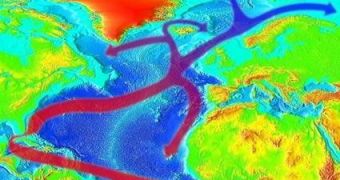The change in the circulation patterns of oceanic currents is likely to have been the key mechanism for the abrupt climate change that took place during the last glacial period of Earth more than 21,000 years ago. If this is indeed true, then air temperature and wind speed could have also had a significant contribution to the process. Now, researchers from the Complutense University and the Potsdam-Institute for Climate Impact Research bring evidence that variations in the surface wind could have influenced to a great extent the circulation of the oceanic current in the North Atlantic.
The study identified small alterations in the superficial sea winds that catalyzed the onset of climatic change taking place during the last glacial period, although the exact cause triggering the ice ages hasn't been found yet. "If the glacial climate had been in the vicinity of that point, small wind changes could have caused sudden and significant climatic changes during that period," says Marisa Montoya, part of the research team carrying out the study.
With the help of climatic simulations known as the Last Glacial Maximum, the team was successful in proving that a certain variation in the speed of the wind can produce a significant impact on the dynamics of the oceanic current, suggesting that this particular factor had one of the most important roles in the climatic change during the last glacial period.
The results obtained from the Last Glacial Maximum simulations were then compared against similar results obtained from climatic reconstructions created with the help of data gathered from natural elements, and appear to confirm the theory that wind speed was one of the physical mechanisms for the climate change that took place during the respective period of time.
Oceanic current circulation is one of the most important factors in the regulation of the global clime by transporting warm waters from the low latitudes of the planet towards the poles, thus softening the climate in areas such as Norway or Ireland, as opposed to other areas located at similar latitudes which cannot benefit from this effect. The study now suggests that the change in the circulation patterns of oceanic current could have been triggered by the variation in the speed of surface winds.

 14 DAY TRIAL //
14 DAY TRIAL //